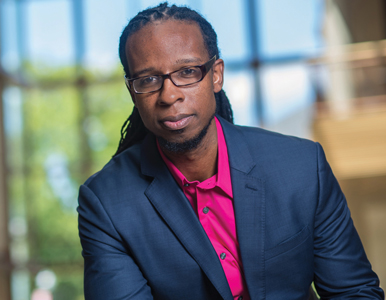
From Democratic presidential candidate Joe Biden discussing his record on civil rights and race to President Donald Trump navigating the fallout of his Twitter attack against four congresswomen of color, the rebuttal to criticism of such behavior is often identical: “I don’t have a racist bone in my body.”
When a racist idea is challenged, says Ibram X. Kendi, director of AU’s Antiracist Research and Policy Center, denial tends to follow.
“If we’re defining racist as a fixed category—as a label that can never be removed, an evil person, a white supremacist—then typically most people are going to want to distance themselves from that,” Kendi explains. But the fact is, “You often have well-meaning people who are [espousing] or supporting racism or being racist. [Thus] I’m arguing we should be defining racist as a descriptive term.”
In his new book, How to Be an Antiracist, Kendi contends there is no middle ground when it comes to racism—but rather a series of day-by-day, moment-by-moment choices that can be described as either racist or antiracist.
“One either endorses the idea of a racial hierarchy as racist or racial equality as an antiracist,” he writes. “One either believes problems are rooted in groups of people, as a racist, or locates the roots of problems in power and policies, as an antiracist. One either allows racial inequities to persevere, as a racist, or confronts racial inequities, as an antiracist.”
Hailed by the New York Times as “the most courageous book to date on the problem of race in the Western mind,” Kendi’s “stunner of a book” landed at number two on the paper’s best seller list after its August release. How to Be an Antiracist serves as a natural follow-up to Stamped from the Beginning, Kendi’s 2016 National Book Award-winning work about the history of racist ideas. While touring for Stamped, he discovered audiences wanted to learn what they could do to counter racism in their daily lives.
A good start is ditching denial and embracing admission, acknowledgement, and reflection—what Kendi’s coined the “heartbeat of antiracism.”
“Self-criticism is essential, largely because many people have been raised to be racist. That is the norm, and it’s almost like an addiction,” says the 2019 Guggenheim Fellow. “When we begin to say, ‘I’m going to move past this addiction,’ it has to be demonstrative and it has to bean everyday process.”
In order to properly describe that journey, Kendi blends history and academic research with personal anecdotes. He opens the book with a difficult story about his prizewinning speech in a 2000 Martin Luther King Jr. oratorical contest. Kendi argued that black youth were “the most feared in our society” and blamed the African American community rather than racist ideas and policies.
“I did not realize that to say something is inferior about a racial group is to say a racist idea,” he writes. “I thought I was serving my people, when in fact I was serving up racist ideas about my people to my people.”
Recounting his upbringing in Queens, New York, his college experience at Florida A&M University, and his career in academia, Kendi demonstrates that racism is not a monolith, but an ill that permeates race, culture, space, class, gender, and sexuality. Personal narrative was “completely new for me,” says Kendi, who holds appointments in the School of International Service and the College of Arts and Sciences. “I’m quite private, so the thought of publicizing my story and some of the most shameful moments of my life was difficult, but necessary.”
Kendi concludes How to Be an Antiracist with an emotional chapter about his cancer battle, as well as those faced by his wife and mother. Diagnosed in 2018 with stage 4 colon cancer—which has a 12 percent survival rate—Kendi beat the odds through six months of chemotherapy and surgery. He likens his struggle to the existential threat of “metastatic racism,” but he believes that, too, is curable. Kendi dedicated the book “to survival.”
“If we believe that we can heal from metastatic racism, then we will have the wherewithal to actually endure the pain that is going to come and to be willing to fight for antiracism,” he says. “We have to believe change is possible in order to bring it about.”